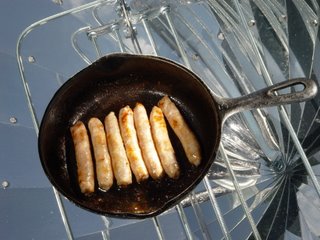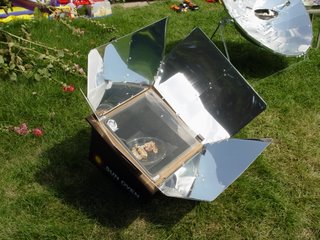Making rice in a solar cooker is a bit different than making it on the stovetop. Because of the intense energy applied to food (and wasted heating up your kitchen) in stovetop cooking, pots boil over and water evaporates into the air. Not so with a solar cooker. Therefore you should use about half the water you would normally use for making rice. The proportion should be 1 cup rice for 1 cup water.
I crushed some fresh garlic that my father grows in his garden into this pilaf. There will be no stirring, so all the ingredients are going in together raw. Add some chopped onions, and fresh peas. I also added saffron, salt and pepper. You can add whatever strikes your fancy.
Here's what my pilaf looked like before I put it into the pre-heated
Sun Cook, which reached a temperature of 300 F in about 40 minutes with some intermittent clouds.

Cooking took only an hour, after which I had a pot of rather delicious rice pilaf. No greenhouse gases were emitted while cooking this meal. Of the ingredients I used, only the garlic was grown by my family. Peas and onions were locally produced organic. The rice came from Vietnam, and the saffron from Spain.
Here's what my rice looked like immediately after cooking was complete.

I'm going to start looking for more locally produced cereal grains to eat, inching ever closer to that "hundred mile diet" goal. Finding locally produced grain products is nearly impossible, given the total dominance of global grain and agriculture by conglomerates such as Cargill, Monsanto, DuPont and Archer Daniels Midland. These companies turn oil and gas into corn, wheat, soy and canola to be consumed and wasted in a thousand processed products we don't really need, and which only offer a false promise of a future free from the limits imposed by the earth.
Peak Grain
Recently it's come to my attention that global stockpiles of cereal grains are at historic lows not seen since the early 1970's.
NOW Magazine has an excellent summary.
Harvests of grain all around the world are being damaged by the
great global drought of 2006. Today in Toronto where I live it's 36 degrees C, and it feels like 45C. Some of the areas affected by the drought on the USA and Africa can be seen graphically
here.
This global drought is
pushing up prices for cereal grains, and some experts fear shortages as predicted crop yields are going to be down in the USA by as much as 23%, in Spain as much as 50%.
This drought is being caused by man's introduction of billions of tons of pollution and greenhouse gasses into the environment through our oil, coal and gas driven economy.
What will we eat when the inputs which are necessary for mechanized agriculture are no longer available, or too expensive for some? The false promise of "techno utopia" will be exposed as fossil fuels decline, and our dependence upon them for our food is revealed. The way into man's heart is through his stomach, someone once said.
I am attempting to gain a small measure of food independence by growing organic heirloom vegetables in my tiny backyard. However not even in my wildest dreams could I feed myself full time on what I can grow. Right now my diet is supplemented by a tasty crop of chicory, various herbs including basil, oregano, thyme, sage and mint, a number of organic tomatoes including Black Plum (so tasty) Purple Cherokee, Green Zeebra, Kosmonaut Volkov, Blondkopfchen, Matt's Wild Cherry, (a 10 foot tall vine laden with tiny sweet fruit) as well as kale and some small beets. No, I don't like tomatoes at all!
Though I started this blog to document how to cook your food in a "first world" country using as much solar energy as possible, I don't think I can separate the cooking of my food from the food itself, where it comes from and how it gets to me. In order to really cook without carbon I need to take a holistic approach to explore all areas of my relationship with food, cooking, the natural energy flows of mother earth, and the temporary high our civilization obtained from cheap fossil energy. This blog is about coming down off that high.
In the near future, Canadians are going to have to confront a world that is fundamentally different from the one we're used to dealing with. Our relationships with each other will be tested, and one of the biggest ones is going to be the relationship between food producers and food consumers.
If you look at the history of the last 150 years in Canada, or the history of any developing nation today, one of the bigger observable demographic trends has been the decline of the use of manual labour on the farm, and the substitution of mechanized labour, powered by oil. Of course this has led to increased yields of some crops that were suited to monoculture and industrial transport. But it has also resulted in soil erosion, decreased soil fertility, the loss of species diversity, the death of ocean life from toxic fertilizer runoff, not to mention our total dependence on declining supplies of oil and gas for feeding the world.
As industrial agriculture grew, labour moved from country to city factory in search of industrial work. From being a servant of the fields, we became the slaves of, and also dependent on an industrial machine.
That industrial machine is beginning to break down now, and we're going to have to re-connect with each other and with the natural rhythms of the earth if we want to maintain our life on this planet.
My mother's family were settlers and farmers in Canada for four generations until my mother's family finally moved off their Saskatchewan farm in the early 50's. Her son will return to the land for sure, just like other members of my generation, who are not used to producing the food they consume, or producing the energy they use to cook it. Here's to our forthcoming lesson in adaptation. Bon appetite.















